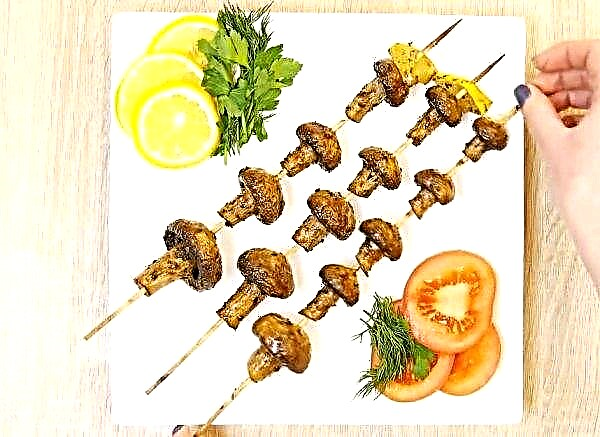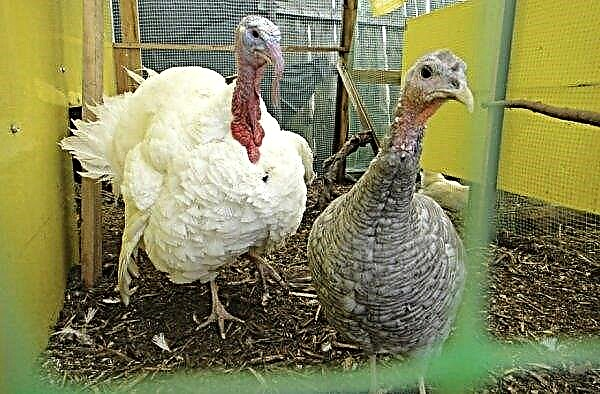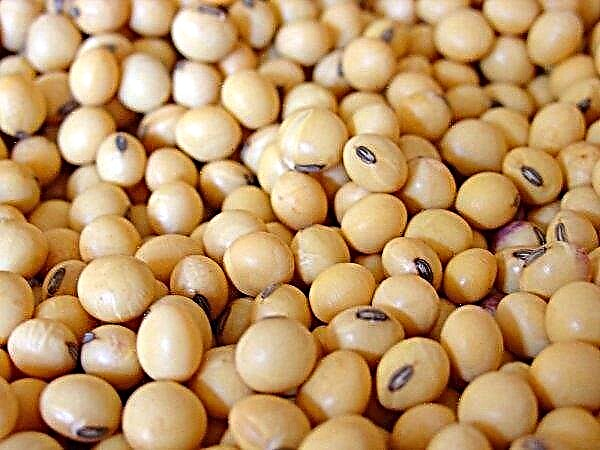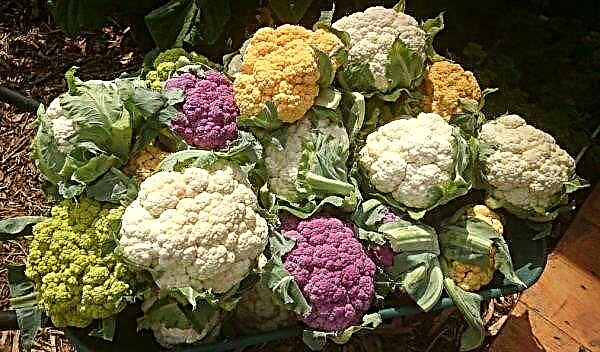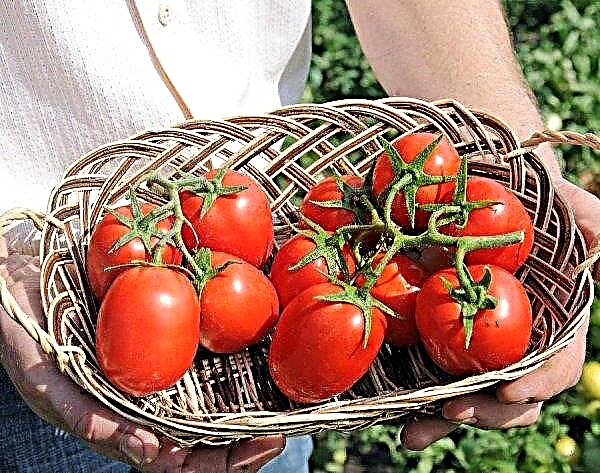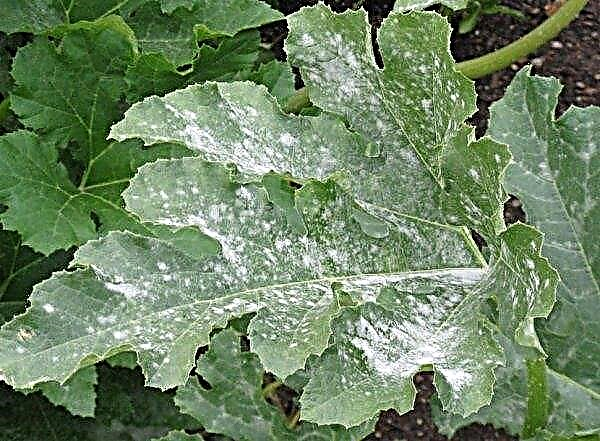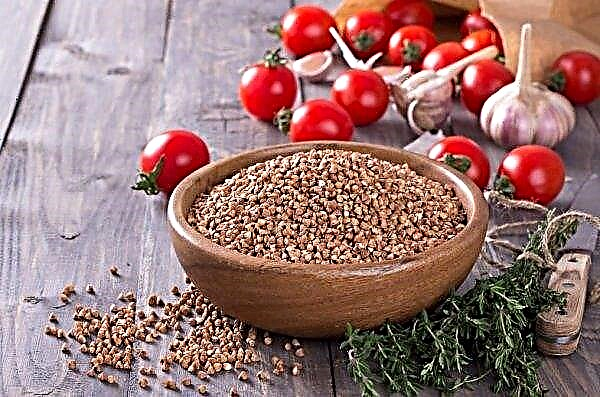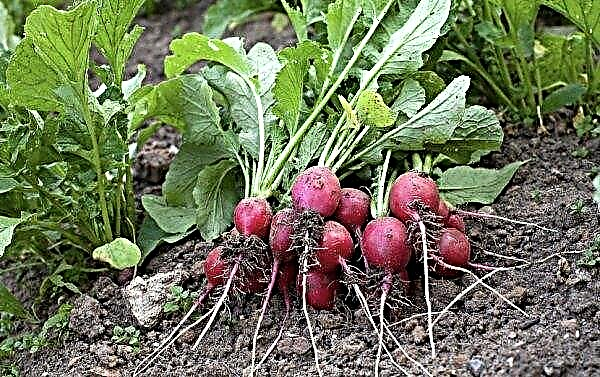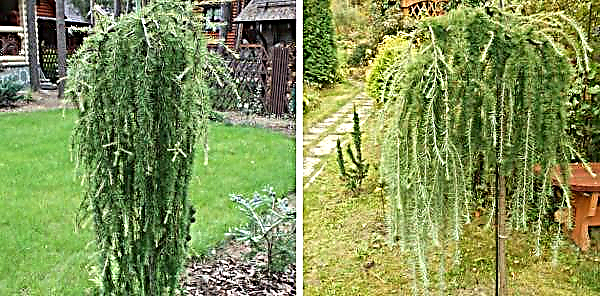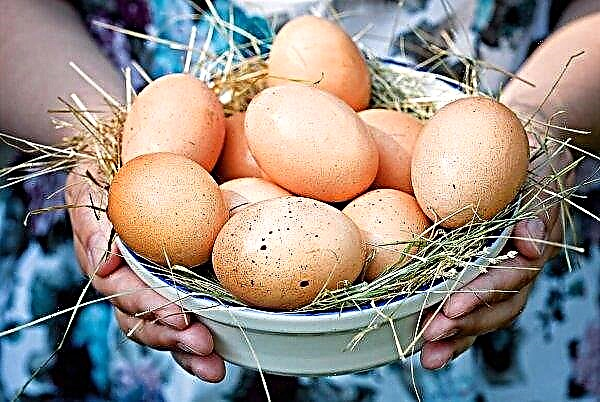Turkeys are the third most popular poultry after chickens and geese. They are appreciated due to the good meat yield and dietary properties of the product. But why, having such qualities, are they only in third place in popularity? The point is their weak immunity. To get good offspring of turkeys, you need to make a lot of effort. The rules for the care and feeding of young animals will be discussed in this article.
Digestion Features Turkey
In turkey poultry, the intestines are longer than in an adult bird. So, for one gram of the weight of a newborn turkey, there is 15 mm of intestine. At the age of ten days, this ratio is slightly less - 8 mm / kg.
Due to this feature, the food that enters the intestines is digested quickly, so that the chicks gain weight intensively, they must be fed often.
Important! If stale food enters the intestine, then it will disrupt the microflora, because of which there is a blockage of the organ and, as a result, the death of the feathered.
Feeding rules
As you can see, the turkey organism is very moody. He needs a certain approach, therefore, in order to successfully feed the chicks from birth to slaughter, you must follow the rules of feeding:
He needs a certain approach, therefore, in order to successfully feed the chicks from birth to slaughter, you must follow the rules of feeding:
- Food should be given at the same time, then weight gain will occur evenly, and the young body will be easier to adapt to new feeds.
- In the summer, it is necessary to adhere to the walking content of the bird. With young herbs, the body will receive all the necessary substances.
- In order for the body to get enough nutrients in winter, it is necessary to harvest birch, linden, fruit brooms in the summer.
- A good prophylactic against many ailments is crushed needles.
- In the morning and evening feeding, it is desirable to give compound feed and grain, and in the afternoon wet mixes with greens.
How to make a diet for turkey poultry at home
For young animals, it is best if their mother feeds them. In those cases when it is not there, it is necessary to correctly draw up a diet from the very first hours of a turkey’s life. The diet of young animals does not depend on the breed. In the first month, the feeding pattern is the same. Only the number of meals is different.
The diet changes slightly as the chicks grow older. At this age, the basis of their menu is animal protein (grated chicken egg), cottage cheese, greens, corn, grain, and mixed feeds.
The diet can have the following form (the table shows the daily rate of each product).
| From day one to twentieth | From three weeks to a month | One to two months |
| Yogurt, 20 g | Yogurt, 20 g | Crushed corn, 20 g |
| Corn, 40 g | Chopped corn, 38 g | Wheat groats, 20 g |
| Wheat groats, 15 g | Wheat groats, 20 g | Barley groats, 21 g |
| Barley groats, 12 g | Barley groats, 14 g | Bran, 20 g |
| Millet, 10 g | Fishmeal, 15 g | Fishmeal, 10 g |
| Fishmeal, 12 g | Meat and bone meal, 5 g | Meat and bone meal, 2 g |
| Meat and bone meal, 5 g | Fresh herbs, 30 g | Ground Wheat Grains, 10 g |
| Fresh herbs, 5 g | Shell (crushed) and chalk, 2.5 g | Chopped corn kernels, 10 g |
| Chalk and shell, 2.5 g | Fish oil, 2 g | Fresh herbs, 60 g |
| Fish oil, 2 g | Salt, 0.2 g | Chalk and crushed shell, 2.5 g |
| Salt, 0.1 g | Fish oil, 2 g | |
| Salt, 0.3 g |
 In order for the food eaten to be well digested, young animals must be provided with free access to water. It should be at room temperature, and in order for the bird to suffer less from gastrointestinal problems, it is recommended to add a couple of drops of potassium permanganate to the water.
In order for the food eaten to be well digested, young animals must be provided with free access to water. It should be at room temperature, and in order for the bird to suffer less from gastrointestinal problems, it is recommended to add a couple of drops of potassium permanganate to the water.In cold weather, the diet of turkeys consists of grain, animal feed, root crops (potatoes, beets, carrots), vegetables, dried herbs, mountain ash, pine needles. Feeding turkeys in summer is easier than in winter, as they are sent for grazing during this period, where they themselves get their own food.
To make the menu a little more diverse, cereals, compound feeds, fruits, vegetables and mash mixes based on these feeds are introduced into it.
As soon as onions are introduced into the diet of young animals, you can begin to give other greens.
Here are some wild herbs that will be beneficial for the chicks:
- dandelion;
- alfalfa;
- clover;
- plantain;
- nettle;
- sagebrush;
- gentian;
- yarrow.
From garden greens:
- dill;
- parsley;
- garlic;
- salad;
- greens of wheat, barley.
 From aquatic vegetation:
From aquatic vegetation:- duckweed;
- rdest;
- salvinia.
Important! The presence of aquatic vegetation in the diet significantly improves the quality of meat and provides the body of the bird with natural vitamins, which means that there is no need for synthetic ones.
Often people involved in breeding turkeys are interested in whether it is useful to give the bird food from the table, since earlier rural residents often diversified the diet of their birds in this way. This approach is beneficial, but the digestive system of turkeys must be considered.
Here's what turkeys eat:
- boiled potato (helps to quickly gain feathered weight, is given in crushed form mixed with feed from a month of age);
- beets, pumpkin (raw vegetables are chopped and given with regular food from 4 months);
- cucumbers, zucchini, cabbage (improve egg production, are given, like green feed);
- bread (dried white, introduced to the menu in a small amount in spring and winter to replenish energy reserves);
- millet porridge (only in the form of cereals).
Newborn
Freshly hatched turkeys are not fed. They need 3-4 hours to dry. At this time, they are soldered with clean water with glucose, as well as vitamin juices (a mixture of carrots, alfalfa, nettle). The fluid flows into the beak through a pipette. When the kids dry, they are given a finely detailed boiled egg. The food should be laid out on a rag so that excess moisture is absorbed and it is more convenient for the chicks to peck the food.
When the kids dry, they are given a finely detailed boiled egg. The food should be laid out on a rag so that excess moisture is absorbed and it is more convenient for the chicks to peck the food.
Daily allowance
Starting from the first day of life in the diet of turkeys, in addition to the egg, crushed grass appears. Such food can be replaced with special compound feeds.
In the first three days, the young should eat a mixture of boiled porridge, potatoes and eggs. Food is also laid out on a rag. You can add crushed grain, green onions, cottage cheese, carrots to this mixture. It is imperative to give a mash of nettle, alfalfa, clover, colza, wheat dart.
Wet all ingredients with broth. Feed every three hours in small portions (approximately 9 times / day).
Weekly
Seven days after the birth of small turkeys, they can already run and get their own food. Nevertheless, their menu does not change much. The portion is only slightly increased. You can add purchased or homemade compound feeds from grain, sunflower meal, peas and chalk.
From 10 days
From the 10–11th day of the life of the chicks, the gap between meals is gradually increasing. The portion size also increases. Greens are mainly given in the daytime. Potatoes are gradually introduced into the diet. First, 5-7 g / individual. If the body perceives normally a new feed, then the dose gradually increases to 55-60 g / individual. Sour-milk products, meat-bone and fish meal, yeast are necessarily given.
If the body perceives normally a new feed, then the dose gradually increases to 55-60 g / individual. Sour-milk products, meat-bone and fish meal, yeast are necessarily given.
In the diet of two-week-old turkey poultry feeds become the main food. All other products remain in the same volume.
Important! Before each feeding, the feeder must be washed from food debris, as stale foods can cause serious harm to the young body.
Monthly
Monthly chicks become less active, therefore it is enough to feed them three to five times a day, and in order to prevent fat deposition, compound feeds are excluded from the menu. Now the diet is based on cereals and waste from these crops, herbs, bran, dry residues of animal origin. Wet mixers are prepared from minced meat and meat waste, fish with the addition of grain and greens.
From 1 month you can give whole grains, preferably in the evening feeding.
In a month and a half, the diet practically does not change, except that the mash mixes are prepared mainly on greens.
Two month
From 2 months young animals begin to feed with chopped corn, bran. These foods contribute to rapid weight gain. Some poultry farmers believe that corn and bran should be present on the bird menu from two months before slaughter. Sprouted grains and boiled potato peelings are also given. With the advent of the warm season, it is advisable to transfer 2-month-old chicks to free-range maintenance. At the age of two months, young animals feed three times in winter and four times in the warm season.
Sprouted grains and boiled potato peelings are also given. With the advent of the warm season, it is advisable to transfer 2-month-old chicks to free-range maintenance. At the age of two months, young animals feed three times in winter and four times in the warm season.
Three month
At 3 months, the number of meals does not change for the chicks, and the diet is as follows:
- dry animal feed;
- cereal waste;
- greens, grass;
- wheat bran;
- meat and bone meal;
- yeast bread;
- salt.
3-month-old turkeys can be given premixes as vitamin-mineral supplements.
Did you know? Poultry will grow and develop correctly only if they are taught to eat in small portions. If they are given plenty of food, they can quickly overeat, because of which digestion is disturbed and there will be no decrease in the intestines, which will adversely affect the weight gain.
Features of feeding broiler breeds
Broiler breeds are fed according to a special scheme, as they must gain weight quickly. It should be borne in mind that the smaller the mass of cross, the less requirements for its diet. Since the birth of broiler turkey poults, they are fed with special compound feeds. PC6, containing corn, barley, peas, is ideal. From the 21st day, PK6 feed is replaced by PK / 2. It includes a number of natural premixes necessary for the development of a three-month body.
Since the birth of broiler turkey poults, they are fed with special compound feeds. PC6, containing corn, barley, peas, is ideal. From the 21st day, PK6 feed is replaced by PK / 2. It includes a number of natural premixes necessary for the development of a three-month body.
If you do not want to spend money on compound feeds, you can cook them yourself.
You will need:
- 50% crushed corn;
- 16% wheat;
- 14% meal / meal;
- 12% kefir;
- 8% of barley.
Such a mash is intended for chicks up to the age of 14 days.
For older individuals, another mixture should be prepared:
- 48% of corn;
- 19% oilcake;
- 7% meat, bone or fish meal;
- 13% wheat;
- 5% yeast;
- 3% grass;
- 3% back;
- 1% feed fat.
A similar mash is prepared for the monthly young stock, but with the addition of barley and chalk.
What not to feed turkey
Turkeys are strictly forbidden to give:
- spoiled food, poor quality food;
- wet mixes prepared earlier than a quarter of an hour before feeding;
- fiber (adults only);
- whole grain, coarse cereals (only from a month old);
- sweets;
- very salty food;
- hemlock;
- cycutu;
- belladonna;
- cockle;
- caustic buttercup;
- rosemary;
- wolf bast;
- wingbell;
- aconite.
Poultry Care
Successful raising of turkey poultry is possible not only subject to the rules for compiling their diet, but also with proper home improvement.
Room requirements
Newborn turkey poults are very vulnerable to low temperatures. To make them comfortable, in the room where they live, in the first five days of their life, they should maintain a temperature of +35 ° C. On the sixth day, you can lower it to +30 ° C, from the eleventh to +20 ° C. The temperature is lowered by ventilation and ventilation. In winter, the temperature should not fall below +5 ° C. For this, windows and doors are insulated, the floor is lined with sawdust or straw, and if necessary, infrared or conventional lamps are used for heating. Humidity is maintained at around 50-60% year-round.
The temperature is lowered by ventilation and ventilation. In winter, the temperature should not fall below +5 ° C. For this, windows and doors are insulated, the floor is lined with sawdust or straw, and if necessary, infrared or conventional lamps are used for heating. Humidity is maintained at around 50-60% year-round.
Important! How to adjust the temperature, tell the turkeys themselves. If they are piled up and do not go to eat, then heat should be added. Lying with an open beak, spreading wings in different directions - it's time to lower the degrees.
The first two days of life of young animals, the light in the room should not turn off. From the second day, the daylight hours are gradually reduced by half an hour so that on the 20th day of the life of the chicks, the daylight is 16 hours. Three-month-old chicks need even less light.
In the room where the bird is kept, drinkers must be standing. It is advisable to choose them indoor, so that the chicks do not climb into them. It is recommended to keep separate drinking bowls for water and for yogurt. The feeders should also be partially enclosed and made of durable materials.
Tanks for food and water are located in the most lighted place of the house, as the chicks in the early days are still poorly oriented in space.
Disease prevention
The immune system in turkeys does not work well, so they are often attacked by such ailments:
- Smallpox. Sick individuals refuse food and water, become lethargic, disheveled. Infected birds are burned, and the rest are vaccinated with embryo vaccine. For preventive purposes, vaccination is carried out at 6 weeks from birth.
- Worms. Helminthic birds quickly lose weight. It is necessary to carry out deworming of piperazine sulfate, phenothiazine. To prevent infection, you need to regularly treat the room with disinfectants.
- Respiratory Mycoplasmosis. The bird is disoriented, gait swaying, eyes sore. The introduction of Chlortetracycline or Oxytetracycline (4 g / 10 kg of food for 7 days) will help to overcome the disease. So that the disease does not attack, it is necessary to feed the animals in a balanced manner, clean the turkey pit on time, constantly ventilate the room.
- Tuberculosis. Sick birds refuse food and water, do not move, indigestion is observed. Destroyed individuals are destroyed, the rest are transferred to another place, the room is ventilated and quartz. To prevent turkey disease, it is always necessary to give clean water, regularly clean bedding, disinfect equipment, and ventilate the room.
- Histomoniasis. Causes indigestion, rapid weight loss. Patients are isolated, Furazolidone, Osarsol, Phenothiazine are added to food. The room is disinfected. Prevention - timely disinfection.
- Hard goiter. Appears due to unbalanced nutrition. Be sure to give chalk, shell rock, small gravel. The bird is sent for slaughter.
- Hypovitaminosis. Eyes become inflamed. Give a complex of vitamins. For prevention, the diet is enriched with vitamins and minerals.
- Diarrhea. Brown - food is not suitable for young animals, white - infection. Chamomile broth or a solution of potassium permanganate is drunk. If to no avail - antibiotics.
- Foot disease. Sick birds roll down. The diet is changing. Additives are introduced: eggshell, chalk, shell rock. In food, the content of soy, fat, and corn is limited. The listed additives should be present in the diet of the bird all the time, then there will be no problems with the legs.
- Newcastle disease. Infectious disease causing paralysis of the limbs. It is treated with a vaccine, but not always successfully. As a prophylaxis, it is necessary to give birds vitamins, minerals, herbs, cottage cheese.
- Rhinitis. It is treated by changing the temperature regime and drinking dill broth, infusion of violets, strawberry foliage.
 With good feeding and proper conditions, young and large poultry can grow from young turkeys.
With good feeding and proper conditions, young and large poultry can grow from young turkeys.Did you know? Everyone knows the sound «kicks» Only male domestic and wild turkeys publish. With the help of this sound, the male informs the others that this territory belongs to him and lures the females.
But in order to get a large percentage of meat yield, the poultry breeder needs to sweat pretty, nursing young animals. In no case should you let everything drift.

